| Urban
and Social Articulation |
| MEGACITIES, EXCLUSION AND “WORLDIZATION” |
…”A
city is defined by its contrasts; it always wants to explode and does
not tolerate barren rules… An unforgettable city is an immense conglomerate
of images”
Wim Wenders
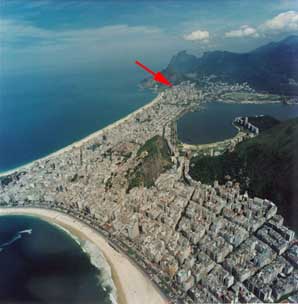
Aerial
view of Copacabana, Ipanema, Leblon and
Rodrigo de Freitas Lagoon, and
the favela of Vidigal where indicated.
In
the Latin America continent, the last twenty years have revealed a new
phenomenon provoked by a process that has two main components: on the
one hand, the confluence of an increasing interconnection and dependence
of the movements of capital (financial “globalization”), and,
on the other, the substitution of technologies originating from the transition
of the mechanical to the electronic age, affecting administration and
management as well as the productive process. This phenomenon has its
urban consequences. It contributes to the geographic dispersion of economic
activities through the systemic integration that the interconnection of
the economic activities generates, and to the renovation and expansion
of the central urban functions. It stimulates the intensification of the
social exclusion of large sectors of the population, resulting in marginalization,
violence and the destruction of congenial living conditions. This is clearly
manifested in the production of the “broken city”, between
the so-called “formal” (quarters) and the “informal”
(shantytowns) areas and the incontrollable sprawl.
This process of increasing integration at world-wide level is characterized
by the formation of a global network of interconnected megacities throughout
the world, forming a new topography. It also creates a new condition of
centrality. This is true at the “macro” (continental) as well
as the “micro” (the inner core of each urban structure) level.
On these two levels, we perceive the formation of new geographies of centrality
- a metropolitan network of urban nodes on the one hand, and rhizomatous
pattern of the city, on the other. Rhizomatous pattern in this sense is
a type of “structuration” that not implies a sintetic relation
between the elements; that refuse a notion of hierarchical order; that
possess a quality of patchwork, a radical heterogeneity.
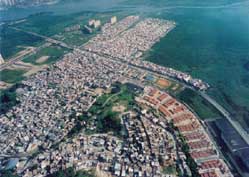
Aerial
view of the favela of Rio das Pedras,
Rio de Janeiro; 12.000 families.
PARADOXAL
PROCESS
The
current paradox evident in the urban field is that, while the telematics
maximizes the potential of geographic dispersion, the process of economic
“globalization” imposes a logic that request strategical places
endowed with enormous infrastructure concentrations of labour, equipments
and buildings. However, the combination of new organizational capacities,
new technologies and new growth sectors creates, in Latin America countries,
in addition to new centralities, an enormous increase in marginality.
The variety of processes in course, related with re-territorialization
of people and economical and cultural practices, has its urban symptom
in the growth of the informal sector of the economy, that is, the occupation
of sidewalks, public squares and residual spaces by illegal vendors and
miscellaneous artisans in both formal and informal sectors of the city.
Thus, in the present increasingly interdependent economy, extremely sensible
to the turbulences, the “local” turns internationalized (adopting
guidelines of behavior and consumption originating from very distant realities)
and the “global” becomes “local” (showing anomalous
”insertions” in the midst of the urban network).
This creates a demand, from the point of view of the interventions in
the larger cities of Latin America (highly complex organisms where logics
of the most varied nature are intercepted) of a concept of urban intervention
capable of articulating, from the moment it is formulated, the physical
questions (urbanistic, infrastructural and those related with the environmental
patrimony) with social (cultural, economic and existential) and ecological
(in its three dimensions: social, mental and environmental ecology).
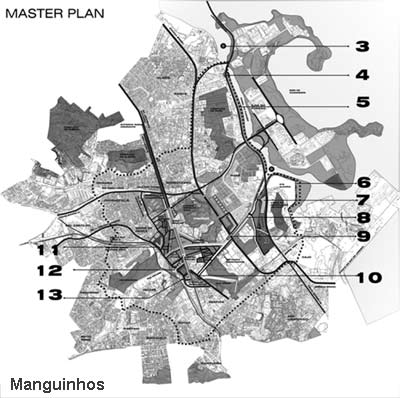
URBAN POLICY
In this context, for the development of urban policies, one of its basic
components being the battle against the exclusion of the underprivileged
majority and the improvement of the quality of life of the population
which includes considering the urban structure as a whole. This raises
the central question of connectivity between the “formal”
and “informal” parts of the city. In the largest Latin American
cities, the percentage of “informal” city, in some cases,
is greater than the “formal” city (such as in Caracas where
the informal sector covers 60% of the city´s total area, and Lima,
70%). In the majority of cities, this percentage is also high, varying
from 30 to 50% in the two largest countries of the subcontinent, Mexico
and Brazil.
Another important component of urban policies into which urban design
must fit is the contribution it can make to improve the participation
of the citizens. This would demand integration with programs promoting
the creation of a productive base capable of generating jobs and a satisfactory
income. As it is well known, the urban policies would be one of the most
efficient ways of achieving this.
It is this crossing, this amalgam of the physical with the economic, the
cultural and the social, that makes it necessary to think from the point
of view of urban articulation of the city, consider, at the same time,
as an intersection of theoretical-disciplinary field, and as ordered practices
of systemic character. To do this, we need to approach urbanism, architecture
and landscaping urbanism, in a democratic spirit, sensible to the dissonances
and diversity, able to act in complex ways such as in megacities. In this
context, it is necessary to start from the “emergencies”,
that relate to a multicondicionality that, hinder the simplification of
one cause; therefore, emergency, the overlapping of multiple logics, and
uncertainty, must be thought at the same time. Thus, urban design must
be able to function as a modulator of interchange between each specific
sector and the city as a whole, focusing the importance of relations between
sites and objects, and their established uses, together with proper objects,
highlighting the space, besides occupying, well occupied, the places of
settlement.
Urban design in the current simultaneous conditions of planetary interconnection,
uncontrolled urban “explosion” and social exclusion, cannot
resign to searching for guidelines, speculating on potential orders and
schemes, imagining forms of looking at the contemporary city as a process
whose order, complex, always in mutation, demand new devices, conceptual
and instrumental, which will to be able to operate.
SPACES OF FLUXES
The challenge consists in the capability to compose spaces of flux, to
be included in world-wide networks, with the consolidation of existing
centralities aimed at improving the performance of urban structure. This
implies the search for differentiated levels of coherence, singularized
by the handling of the intensities through the connections to be carried
through. Thus the importance of establishing the basic guidelines for
infrastructures and their connecting function. The characteristic of this
conductor agent that are the megacities, is the great dynamics of the
urban phenomenon in the new landmark of the capitalism, where each point
of the territory is determined by overlapping of logics whose appearance
is the aleatority, but which are necessary to unmask the form of incidence
in each case.
To be able to be effective in this environment, it is necessary to have
the capacity of “reading” the structure of each specific place
where the main interest, much more than the matters of scale or measure,
is the type of relations which the different sectors maintain among themselves,
as well as the conditions of centrality which will be modified by interventions.
In this urban reading what is especially important is the analysis of
the conditions of edge and borders among the different recognized urban
sectors i.e., the different directionalities, the standards upon which
certain zones are organized with higher intensity than others. The transitions
from private to public spaces, gradual, paused, the passages of public
open spaces to semi-public closed spaces. It is necessary to have a critical
stance in relation to the subject of densities and uses, in order to make
the attractiveness of the open public spaces more powerful.
The urban “system” under discussion is the one which gives
rise to conflicting forces of different origin and directionalities, sometimes
antagonic, intercepting each other, and where the balances are always
unstable. This defines an urban “means” of relational type
that required to deal and to interfere a very sensible “texture”
of relations, characterized by movement and paths, hazard and chaos. In
this context, the global fluxes of capital, information and people ends
up by producing strong local impacts where the security structures on
which social life was based end up by being dissolved. But there exist
societies mainly “connected” and others in which just one
dynamic pole belongs to these global networks. In fact, we find a globalized
sector in all large cities where directional functions are located (i.e.,
interconnected financial centers) and extensive areas detached from the
global networks in which the majority of the quarters and people live
their local lives. What varies, according to the context, is the ratio
of its “disconnected” part; while in Silicon Valley, California,
this ratio is only 10 %, in Lagos, Nigeria, it is 90% and São Paulo
it is half.
An aerial vision of Rio de Janeiro, Caracas, São Paulo or Mexico
City and their influential areas show us a great blotch, a fabric which
gradually disintegrates, decomposes and spreads extensively, without end,
except in those exceptional places that are the edges of rivers, lagoons
or forests. The highways, in this scene, are artificial rivers, as Louis
Kahn said, and as it, joint and separate generating new equipments, misguided,
dispersed, while the old local centers deteriorate or renew themselves,
as the case may be, creating gaps resulting from lack of activity owing
to the surge of new technological-productive logics and the modification
of accessibility conditions.
In consequence, the interpretation of the city as an organism which is
alive and in process of transformation, considering its enormous dimensions,
presents formidable challenges to the spread of the benefits of the urban
life to all its citizens.
The function of urban articulation is to attempt to reorganize and consolidate
textures accomplishing new connections, to give character to disturbances,
to fortify places with identity, to strengthen and/or create new centralities,
to incorporate previous investments and to endow the peripheries with
“prestige” equipment, considering that the interconnection
of circulation and communication infrastructure, the urban fabric and
established uses can only be considered from a multi-disciplinary perspective.
The question is how, although forced to act considering market rules,
we can use urban strategies to generate quality space which does not erase
the recording of territorial communities and to point actions in the direction
of the structure´s general connectivity.
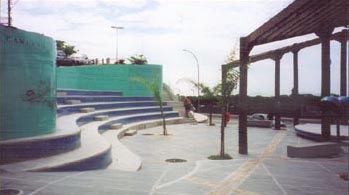
Communitarian
square in Vidigal.
CONFLICTS
AND COEXISTENCE
Today, we can verify a tendency in the way of exasperation of conflicts,
as much as, and at the same time, one inevitability of the coexistence
in this “ocean of signs” that are the megacities, of three
types of differentiated urban spaces:
a_ Spaces generated for the process of traditional accumulation
and substitution, where some architectural parts are identified in an
anonymous background (some of which are by specific “authors”)
constituting centralities, when they reach a certain critical mass, through
the accumulation of functions and ways of life. Within these spaces, the
urban image is the result of community action, interacting in a specific
territory throughout a period of time, as criteria and norms are permanently
being customized and renegotiated. These urban sectors, identified as
neiborhoods (“bairros”), offer features of structural stability
that still define them as visual picture belonging to the “city”.
b_ Spaces that escape to public control (or where this
is very weak) and that occupy great extensions of the surface of the cities,
constituting áreas of impunity, with its proper laws an codes,
that identify as enormous urban peripheries. In some cases, action in
this context would probably require the use of a “war methodology”
or “planning for disasters”. In these spaces without quality,
the role of urban design in determining a new image is basic, so much
to contribute to the general resignifying of the system, as for the improvement
of the quality of life of those that are forced to live there because
of the lack of other alternatives. Urban design in these circumstances
may function permiting places constituted without planning to acquire
an urban responsibility, in a perspective of restoring the dimension of
public space as quality scope. In this sense, to urbanize the peripheries
and “favelas” means to force chaos aiming to inscribe points
of singularization with capacity to produce effects over a wide range.
These sectors of the urban network, which in many cases are not registered
in the City´s plans depict the “noir” aspects of society,
not acknowledged as even existing - “no-places”, intervals,
a time to suffer while moving across the City. However, simultaneously,
there are other spaces open to new possibilities for creativity, urban
innovation and social experimentation. Places where what is “in
process” and what is in “devir” (what is to come) is
in permanent experimentation with a wealth of social relations, and great
permeability of the communitarian and of the individual, are the source,
basic material to be worked for the articulation of the City. Here, the
image, the specific design, has maximum relevance and will lead to the
constitution of an identity focus, enabling the galvanization of the collective
imagination, singularized in every intervention. In this sense, creativity
and aesthetics elaboration are together, because aesthetic is the discipline
that gives sense to things, not just referring to the formal aspects.
c_ With reference to the design of “author”
spaces much in demand by the power of large corporations (wheter national
or multinational, public or private) generally based on special ”themes”
such as entertainment parks, international exhibitions, historical recycling
of port areas, historical centers, “typical” quarters, etc,
these occupy strategic points of territory and are disconnected (whether
voluntarily or not) from the urban structure, constituting, generally
speaking, “islands of fantasy” in the archipelago of the city.
In this types of space, the pictures tend to become commodities, and the
city, a city of “franchising”.
These three types of space tend to remain unarticulated between themselves,
maintaining only relations of proximity; they do not make “urban
texture”, nor do “build city”. To think about these
connections implies reflecting on concepts of “urban edge”
and “urban milieu” and urban articulation strategies.
PHILOSOPHICAL POINT OF VIEW
The city, in the philosophical sense, can be understood as fluxes of the
most varied passing: music, painting, sculpture, architecture, information;
the movement, the time. This flow is made up of successive insertions
and the architect-urbanist who works in it is, constantly moving among
conflicts, commitments, contaminations, interferences and transformations.
For Walter Benjamin, cities are the plural of the humanity, an accumulation
of existences and a multiplication of existence itself; a formidable past
manufactured in assemblage. Understanding a city implies crossing the
mysteries of its surface and urban design must also, to a large extent,
be formulated keeping the eyes and feet very next, as much as possible,
to chosen the site and the conditions under which we are requested to
intervene. Thus, to absorb the spirit and circumstances of a city implies
knowing how to catch its traces, covered up by all sorts of tensions.
For Benjamin, the contemporary city means the dissemination of “all
in the whole”; it has at the same time, the joy of all and its own
joy. In the city, the bodies, the spirits and the things are mixed up
seductively, a seduction which is at the same time of utilitarian and
aesthetic basis.
Therefore, although everything, large cities still have in common with
the original Polis, the fact that it constitutes a whole, fragmented,
that embody the diversity and that precede the individuals, constituting
much more than the simple crowding together of people. It has the capacity
to light the passions, and, in theory, is possible to reach some degree
of rationality in its control. Its law is the accomplishment of a certain
ratio, but knowing that always includes certains areas of “non-sense”;
in which it is necessary to experiment new concepts and new forms of intervention.
These
megacities today constitute the “locale” of contemporary life
which not only congregates, unifies, makes nexus, but which also has the
power to provoke distress and potential. And after weighing everything,
these great cities still include the supporting in common of determined
values, the conscience of a destiny with the others and, from this viewpoint,
the fact that the citizen is able to find an accomplishment condition.
And more of this, is still in these conglomerates of artifice and nature
that a multitude, homogeneous at all, a multitude of humans being, congregated
by sharing (in spite of everything) a certain entail of concord (the possessions
they love as, for instance, a hospitable tradition, a landscape, etc).
Urban design must be capable of articulating this condition of ”locus”,
acting as a bond between citizens.
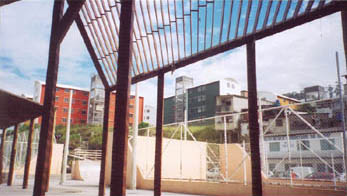
View
of Rio das Pedras square with the relocation buildings behind.
TIME AND SPACE
The concept of urban articulation, therefore, involves a space-time conception,
and it involves a “vision” of the city as a broken totality.
It implies a type of scripture; it is an urban writing, and, as such,
it resemble a palimpsest, that thinks and draws the city, thinking and
drawing itself.
Time is a notion and, in urban interventions, a variable that operates,
and is irreversible. In the urban process, phenomena are observed in one
continuum, for a duration, without evidence or a view of the beginning
or the end, in a state of permanent development and mutation. It resembles
certain perceptions which could be associated with consecutiveness, ordinances,
deduction, seriality, etc.
Space is a dimension, and, as such, implies in materiality, reality, a
pattern, a structure, and is associated with operations such as dissemination,
splitting, induction. The processes in the space imply evolution or involution
transformation of a materiality. But space is also doubt, possibility,
and needs to be conquered.
In this direction, urban articulation implies a type of planning involving
a structure or pattern i.e., the special disposal of its substance according
to group of a whole in parts. Therefore to think about urban space means
establishing an ordinance of ideas covering this feature of extension
and duration from choices that always imply a challenge.
In Latin America, it must act as an activator, in the direction of feeding,
speculating and helping to reason, from a concrete place, about the necessity
of organization and construction of a spaciality that potencialize the
place and its neihgborhood, helping to decide its most serious problems.
Problems that always hold an objective and material spaciality, characterized
by the split between the legal and illegal sectors, the need for non-exclusive
centers of conviviality, for the integration of abandoned areas and urban
emptiness, for the mobilization of the civil society, and University and
the research, and for the re-approximation with centers and organisms
in all the all the world, specially with the European continent which
is the origin of the urban models that had occurred long time ago.
Thus, it involves a hybridization between Planning (using formulas of
a strategic and abstract nature, located over a stated period) and Project
(proposal of tactical nature, expressed through concrete pictures capable
of gaining acceptability over the short term).
From the point of view of Latin America, Urban Articulation will have
to focus on the following issues:
- reflection on the new territorial phase of megacities, rethinking the
relation with the “city within the city”, the “diffuse
city”; thinking about the notion of “productive territories”.
- rethinking new connectivities in urban structure as a whole, generating
new centralities and rearticulating the existing ones,
- the creation of conditions of “urban life” in areas excluded
from urbanity, of the benefits of common urban life through the “creation
of city” in the informal areas,
- reinforcement of the collective character of space through the configuration
of places where the diversity of functions and convivial activities guarantee
attractiveness and potentiality,
- thinking about the collective public spaces in megacities as offering
not only the opportunity of getting acquainted (with open spaces, with
benches, kiosks and fountains) but also as powerful infrastructural supports
on information, interaction and education,
- use the interventions as a means of imprinting a cultural quality on
a place; using urban design itself, as an occasion for a cultural event,
- reflection about the subject of the “edge”, the limit, in
other words, about the subject of “margin” as metaphorical
theme in contemporary city,
- thinking about interventions from the perspective of an urban renovation
policy, including development and infrastructure, that imply “architecturalization”
of space, landscape and infrastructure,
- the interpretation of demands, coming from groups or individuals (helped
by the assistance of psychoanalysis) not as a direct, literal response,
but as a translation into “sensible aggregates” capable of
representing various levels of “consistency”,
- introducing into the “magma” of megacities, an intermediate
dimension implying “small city in the city” as a system of
centralities of collective sites; introducing the small dimension into
the dimension of the megacity. Articulating the small dimension including
elements of bigger force pertaining to the larger dimension, and vice-versa,
starting from existing conditions of basis (local centralities and existing
uses),
- reflecting on what would be a rich mode to inhabit urban space that
involves incorporating “affects”, that is, the capacity to
affect and to be affected by the space,
- searching for a close bond between Urban Design and Architectural Landscape,
considering landscape as infrastructure, as important as transport and
circulation ways. Both urban design and landscaping demand a global reflection
on which a series of disciplines intervene (philosophy, geography, art,
sociology, psychoanalysis, engineering) extending our concepts of space
through its works, accomplishments, inquiries and speculations,
- articulating urban interventions with the protection, construction and
reconstruction of the surrounding landscape substrata,
- thinking about urban questions as articulations among ethics, aesthetics
and politics,
through urban design, to battle against :
......- the reduction of the public sphere,
......- the transformation of public space into merchandising dominion,
......- the transformation of cities in ghettoes of consumption, entertainment
and culture,
......- the lack of structure in the urban texture,
......- the lack of identity of landscaping performed economically rather
than spacially.
......- the increasing costs of “externalities” provoked by
the process of “globalization” , as evidenced in urban spaces
through the increasing division between the people “included”
and the people “excluded”; the increase of the disparity of
investiment in “prestige” equipment in the different urban
sectors; environmental disaggregation and the abandonment, or the inexistence
of public space.
......- simultaneously, the “deficit of city” and the “deficit
of citizenship”, both in the enormous peripherical areas and shanty
towns.

Plan
of the metropolitan projected park in Manguinhos
INTERNATIONAL
DIALOGUE
In this way, the specific task of urban articulation in Latin
America would be capable of to relate the physical with the social and
cultural, reasoning simultaneously at the pragmatic level, the plastic
level and the conceptual level. This involves the challenge of putting
into practice the narrow link between “high” culture and popular
traditions, between the contribution and content of works at the worldwide
level, and the specificity of local circumstances. For this reason, one
of the prior conditions of a project is to know how to ask “the
right questions” about the position and context specificities in
the intervention area in terms of history, economics, technical and the
physical configuration process, as well as about social, cultural and
productive relationships. Places should be “well asked”.
It is also necessary to situate urban articulation problems from the point
of view of creating the conditions for an effective and productive international
contribution, opposed to the globalization of the economy (which has become
a one-way path, a “globalitary” question, a field of restrictions,
pre-defined and mined), a “worldization” (universalization)
of problems (conceived as a field of chances providing plural ways) capable
of making possible a new description of ourselves and our own problems.
In addition, it is highly desirable to analyze the problems from unusual
perspectives and to search for a more efficient use and handling of materials
as well as human resources, inverting the dominant logic and giving total
priority to a “quality” solution to the problems of the excluded
majority which is not only a “peripherial” problem, as has
already been seen, but, due to its extent, it affects the whole of humanity.
We are talking about the participation in an extended “worldialized”
dialogue, through partnerships, agreements, associations and contributions
involving institutions whether publics or privates, and NGO´s, with
specific objectives, putting in place strategic alliances in order to
tackle more ambitious programs (such as Favela-Bairro and others) and
to contribute to the control of the public sphere, acting as guarantee
of adequate use of the facilities.
What is at stake here is the part that urban articulation can play in
the pattern of other alternatives for improving the day-to-day life of
the city´s permanent dwellers, offering a physical environment which
does not need continual isolated “improvements”.
Urban design operates as a multidimensional cartography of subjectivity
production (which has faced a historical and collective confrontation
with modernity) where the cities function as immense machines of subjetivation,
not only individually but also collectively in which what really counts
is not the infrastructural aspect, communications or jobs, but rather,
the capacity of redirecting our urban “devir”, either through
material or immaterial means.
We know that buildings and spaces are capable of functioning as expressive
machines, and that this unleashes effective and cognitive impulses; that
all apprehension of existent, implies a recreation, a reinvention. Thus,
constructed spaces are essentially “production sense machines”
and make individual and collective subjectivity possible.
Therefore, it is necessary to rethink the complexity considering simultaneously
the technical aspects and the economic, ecological and abstract dimensions,
but also, the capacity to produce subjectivity. In order to achive this,
it is necessary to get involved, putting in the first plane the ethical-aesthetical
components, even if we are acting in a continuum, with every type of coercions
(opinions, and functional, economic and social aspects) without allowing
oneself to be dominated by any of them. This aesthetic-ethical responsibility
to live out the margin for maneuvering must be accurately estimated since
we are dealing with ethical questions.
Psychoanalysis will alert us in relation with ethics when, facing the
economic, political, social and cultural determinations, the “projectional”
act must imply an ethical position that, in general terms, can be summarized
as “doing what it is necessary to be done”, knowing that this
duty is not of moral or straight order. It is a duty in which is putting
in play permanently what is “beyond demand”, that is, the
desire in the projectual act. It´s not about trying to please anyone
in a project as form of seduction or harmony, anyway this is not the fundamental
question.
Through urban articulation, and the general overview of multiple disciplines
which involve formalization, the urbanist-architect can, in relation to
the design and its intentions, direct to decisive bifurcations for the
democratic city. He must be capable of establishing the inter-relations
between the ethics (which involves principles) with poltics (which involves
necessary actions for materializing the principles) and aesthetics (which
always implies the defiance necessary to introduce what is new).
Conceived as a strategy of singularization, is the result of the crossing
between individual creativity supported by multidisciplinary interaction,
and the multiple material and social coercion which it must bring together,
and, in this sense, the contributions for the integration of the “broken
city” could be substantial in the Latin American context.
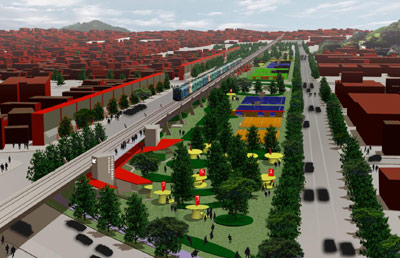
Perspective
of the metropolitan projected park in Manguinhos
Jorge
Mario Jáuregui
|






